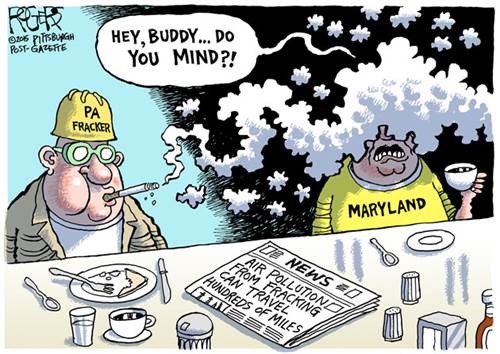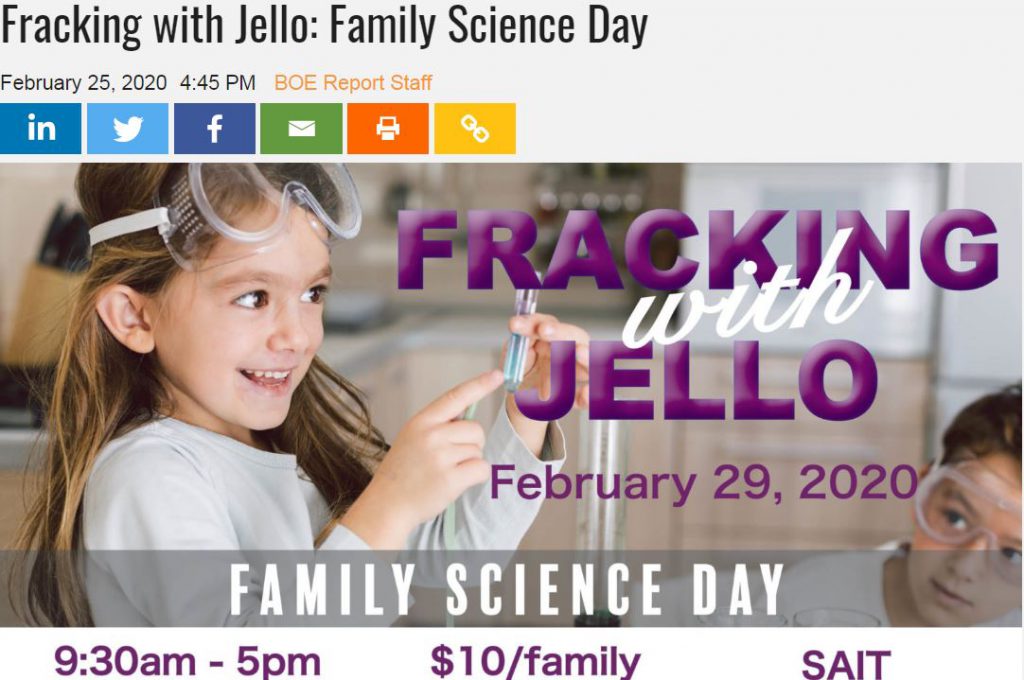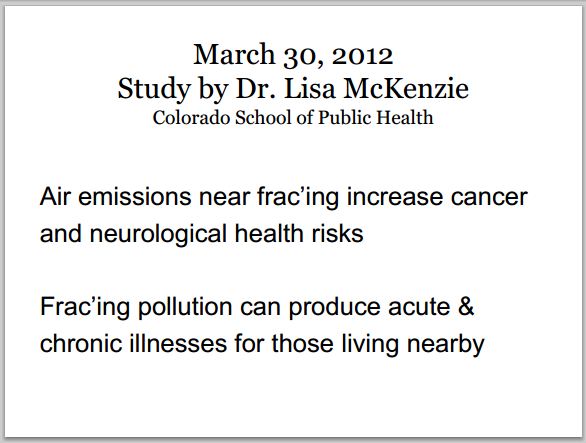
For the First Time, a Harvard Study Links Air Pollution From Fracking to Early Deaths Among Nearby Residents, The researchers studied more than 15 million Medicare beneficiaries living in all major fracking regions and gathered data from more than 2.5 million oil and gas wells by James Bruggers, Jan 27, 2022, Inside Climate News
Western Pennsylvania residents and doctors have been going public for several years with their concerns that fracking for fossil gas has sickened people and may be causing rare cancers in children.
Today, a new study out of Harvard links fracking with early deaths of senior citizens.
Published in the peer reviewed scientific journal Nature Energy, the team of researchers from the Harvard T.H. Chan School of Public Health blames a mix of airborne contaminants associated with what is known as unconventional oil and gas development. That is when companies use horizontal drilling and liquids under pressure to fracture underground rock to release the fossil fuels through a process known as hydraulic fracturing, or fracking.
The closer people 65 and older lived to wells, the greater their risk of premature mortality, the study found. Those senior citizens who lived closest to wells had an early death risk 2.5 percent higher than people who did not live close to the wells, the researchers found.
The study also found that seniors who lived downwind of wells were at a similar higher risk of premature death than those living upwind, when compared with people who were unexposed. In their paper, researchers did not estimate the total number of premature deaths nor the length of time lives were shortened.
Still, the authors said it’s the first study to link mortality among those 65 and older with air pollution from fracking wells.
“Our findings suggest the importance of considering the potential health dangers of situating (unconventional oil and gas development) near or upwind of people’s homes,” said Longxiang Li, a postdoctoral fellow in the school’s Department of Environmental Health and lead author of the study.
The researchers wrote that a variety of activities can cause air pollution around oil and gas wells resulting in increased exposure to volatile organic compounds, nitrogen oxides and naturally occurring radiation.
Those activities can include pad construction, well drilling, hydraulic fracturing and fossil fuel production. Diesel trucks and equipment used to build the drilling pads and to force the fracking fluids deep into the ground also emit pollutants. Pollutants can be released directly from wellheads and from the burning of unwanted fossil fuels, a process known as flaring.
The Environmental Protection Agency says the industry’s release of volatile organic compounds is a major contributor to the formation of ground-level ozone, or smog, which is linked to aggravated asthma, increased emergency room visits and hospital admissions, and premature death. The EPA has proposed what it describes as expanded and strengthened emissions reduction requirements for new, modified or reconstructed oil and natural gas sources.

The study is certain to further animate political debates over the health effects of a controversial method of fossil fuel extraction at a time when fossil fuels are under increasing scrutiny because they are also blamed for contributing to the climate crisis. …
The study’s conclusions are no surprise to Dr. Edward C. Ketyer, a pediatrician from Bridgeville, Pennsylvania, outside Pittsburgh, who has been sounding the alarm about health effects from a fracking boom that transformed the economy and character of southwest Pennsylvania over the last 15 years.
“Living in Southwest Pennsylvania in the middle of the Marcellus Shale region, we have all read the studies on the known health impacts from living near oil and gas operations,” said Ketyer, president of the Physicians for Social Responsibility Pennsylvania. “There have been good studies that have been replicated” on poor birth outcomes, premature births, low birth weights and complications with pregnancies, he said, and also “good data” that shows people living near fracking operations have higher risk of hospitalizations, migraine headaches and upper respiratory tract infections.
“And we are still very concerned about the issue of a spike in rare childhood cancers,” he said, referring to Ewing sarcoma, which is still under investigation in a four-county area outside Pittsburgh.
… Without knowing more about what pollutants people were exposed to and at what levels, research conclusions remain based on indirect or proxy measurement, giving industry supporters “plausible deniability” of the problem. ![]() Which is the real reason (i.e. not trade secrets) why companies refuse to disclose and or lie about the many toxic chemicals they poison people, farms, small businesses, and communities with.
Which is the real reason (i.e. not trade secrets) why companies refuse to disclose and or lie about the many toxic chemicals they poison people, farms, small businesses, and communities with.![]()
Mike Sommers, the chief executive of the American Petroleum Institute, a lobby group, has made the case that overall air quality is better in the United States now because the national gas boom has replaced a lot of coal in power generation.
And last fall, API Vice President Kevin O’Scannlain testified during an EPA hearing that the institute supported new air pollution regulations on oil and gas production but urged the agency “to carefully consider the availability and cost of equipment, labor and other required resources needed to comply with the proposed standards.”
The Harvard scientists acknowledged they were unable to determine which air pollutant or pollutants may explain the premature deaths.
“There are almost no (air pollution) monitoring stations near the fracking wells,” Li said. “Almost all the monitoring stations are in urban areas.”
But the authors wrote that fracking has expanded rapidly and that as of 2015, there were already more than 100,000 land-based wells drilled using directional drilling combined with fracking. Compared with conventional oil and gas drilling, the new methods involve longer construction periods and larger well pads, and require larger volumes of water and chemicals.
Though called unconventional, the drilling practice has become the most common in the United States.
Roughly 17.6 million residents live within about a half mile of at least one active well, according to the study. For their paper, the researchers studied a cohort of more than 15 million Medicare beneficiaries, people ages 65 and older, living in all major U.S. fracking regions, from 2001 to 2015. They also gathered data from the records of more than 2.5 million oil and gas wells. They used two different statistical methods to calculate people’s exposures, while adjusting the findings for socioeconomic, environmental and demographic factors.
“There is an urgent need to understand the causal link between living near or downwind of (unconventional oil and gas development) and adverse health effects,” said Francesca Dominici, a Harvard professor of biostatistics and one of ten co-authors of the study.
Dominici was the senior author last year on a major study that quantified the degree to which increases in fine particle pollution during wildfires contributed to excess Covid-19 cases and deaths in the U.S.
Living near fracking sites raises risk of premature death for elderly, US study finds, Findings are result of first major study into link between premature death in older people and unconventional drilling by Nina Lakhani, 27 Jan 2022, The Guardian
Elderly people living near or downwind from unconventional oil and gas wells such as fracking sites are more likely to die prematurely, according to a major new US study.
Extracting oil and gas through newer or unconventional methods like fracking has expanded rapidly across America over the past two decades with at least 17.6 million people now living within one kilometer of an active well.
Compared with traditional drilling, unconventional oil and gas development (UOGD) is linked to higher levels of exposure to toxic air pollution and poor water quality, as well as noise and light pollution which can be harmful to human health. The impact of fossil fuel extraction – including by unconventional methods – has disproportionately affected low income communities and people of color.
Researchers from the Harvard TH Chan School of Public Health studied the health records of 15 million people on Medicare, the health insurance program that includes at least 95% of Americans aged 65 and older, living in all significant drilling regions from 2001 to 2015. They also gathered data on about 2.5m oil and gas wells covering leading exploration states, from Montana to Texas and Pennsylvania.
The closer people live to an oil and gas operation, the higher the risk of dying prematurely, even after accounting for socioeconomic, environmental and demographic factors such as gender and race, according to the study published in Nature Energy.
Residents most adversely affected are those living nearby and downwind, suggesting toxic airborne contaminants emitted from UOGD sites probably contributed to higher mortality rates. Exposure to toxins associated with unconventional drilling such as volatile organic compounds (VOCs), nitrogen oxides and radioactive materials are linked to a wide range of life-threatening medical conditions.
“Our findings suggest the importance of considering the potential health dangers of situating UOGD near or upwind of people’s homes,” said Longxiang Li, a postdoctoral fellow in the Department of Environmental Health and the study’s lead author.
Overall, elderly residents living near these wells have about 2.5% higher mortality rates than those living far away compared with 3.5% for those who are also downwind.
This would mean thousands of premature deaths linked to the oil and gas boom, though the peer-reviewed study does not include estimates of lives lost.
This is the first major study into the link between premature death in older people and unconventional oil and gas drilling activities, and the first to examine the importance of wind direction. As of 2015, more than 100,000 onshore UOGD wells have been drilled, with many clustered around densely populated residential areas.
“Although UOGD is a major industrial activity in the US, very little is known about its public health impacts. Our study is the first to link mortality to UOGD-related air pollutant exposures,” said Petros Koutrakis, professor of environmental sciences and senior author of the study.
It builds on previous studies that have found residents living near these sites are significantly more likely to suffer prenatal complications, cancers and respiratory and cardiovascular diseases.
As unconventional oil and gas exploration continues apace further research is needed to understand the causal links between living nearby or downwind and adverse health effects, the authors conclude.

2020: BOE Report: Fracking with Jello: Family Propaganda Day at SAIT. Education Alberta style.

Shame on SAIT and BOE. “Fracking with jello” was anti-science and they used Jell-O’s fame and registered trademark (with permission?) to propagandize kids and their families. Did an Encana/Ovintiv and or Osler lawyer advise them to remove the dash to make it “legal?”
2019: Ewings sarcoma: Frac’ing vs Public Health. Are oil & gas industry-funded health studies trustworthy?
2015: Fracing’s long reach: New Study says Fracking Wells Could Pollute The Air Hundreds Of Miles Away

![]() There are hundreds more posts on various studies proving how harmful frac’ing is, to us, workers, our health, communities, the environment, notably air and drinking water, jobs (frac’ers like Encana/Ovintiv kill jobs via automation and greed), and the economy.
There are hundreds more posts on various studies proving how harmful frac’ing is, to us, workers, our health, communities, the environment, notably air and drinking water, jobs (frac’ers like Encana/Ovintiv kill jobs via automation and greed), and the economy.
Think of the cumulative health harms breathing frac’d air; and drinking toxic frac’d water and bathing in it; and living stressed 24/7 by frac and drilling noise; and the relentless polluting noisy dangerous related traffic; and companies like Encana/Ovintiv dumping their toxic waste on foodland in your community; and the stress of regulators shaming, blaming and bullying you if you dare protest or ask questions, and violating your charter rights and judging you a criminal without any evidence or trial if you – heaven forbid – send the regulator a company’s records proving they broke the law; and courts lying about you to smear you and discredit you and your lawsuit; and your own lawyers (my lead was Murray Klippenstein with lawyer-in-training that he put on my case – Cory Wanless, who made his career on me, my suffering and savings) betraying you and the public interest, quitting and withholding that which belongs to you – in clear violation of the rules of their profession. And the stress of watching American judges piss on jury rulings to let law-violating frac’ers off and worse, order the harmed gagged by the law-violating companies, and judges in obvious conflict, letting repeat criminal waste dumpers escape prison to let them keep dumping their toxic loads anywhere they like, including into water ways that communities use for drinking water.![]()

